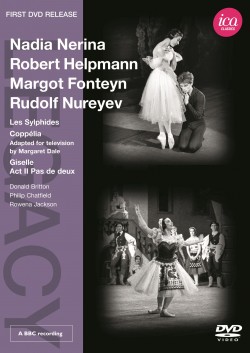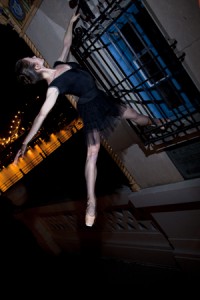by Emily Kate Long
 Part of the ICA Classics Legacy series, this triple bill of Les Sylphides, Coppelia, and Giselle is truly a treasure. It is a rare look at some of the mid-twentieth century’s greatest dance artists performing three of ballet’s most enduring works.
Part of the ICA Classics Legacy series, this triple bill of Les Sylphides, Coppelia, and Giselle is truly a treasure. It is a rare look at some of the mid-twentieth century’s greatest dance artists performing three of ballet’s most enduring works.
Michel Fokine’s Les Sylphides, to the music of Chopin, was restored from a black-and-white 1956 BBC broadcast. It features Nadia Nerina and Philip Chatfield, with Rowena Jackson and Julia Farron in the Waltz and Prelude. On display here is absolute technical purity: subtle, precise bourrees for the women, effortlessly soaring grand jetes and impressive batterie for Chatfield. The mix of proscenium shots and moving cameras give a dreamy, dizzy air to the whole ballet—appropriate for one of the first abstract or plotless ballets. We float right along with Chatfield as the Poet through beautifully geometric formations of sylphs.
Margaret Dale’s 1957 adaptation of Charles Nuitter’s Coppelia is enchanting. It plays out convincingly enough to look more like a silent film than a ballet. Here Nadia Nerina is the star of the show; for one thing, she’s the only woman in this version dancing on pointe. Her costumes are also the only tutus; the rest of the characters are clad in heavier clothing and character boots. Nerina’s alignment and the precision of her incredibly streamlined legs lends easy sweetness to all her choreography, even the devilishly quick Scottish dance. The steps fall away to show her off as quite the comedienne. The overall liveliness and charm of the dancing and acting make the characters come vividly to life.
Last on the DVD is a restored 1962 recording of Margot Fonteyn and Rudolf Nureyev in the Act 2 pas de deux from Giselle. It’s one of his earliest performances in the West, and one of the earliest in their long partnership. Nureyev’s skill as a partner and Fonteyn’s reserved technical style allow Giselle’s story to shine through, even in such a short excerpt. The wonder with which he cradles her makes her seem unreal. Throughout the duet, we see a Giselle who is deciding whether or not she can forgive the man who so carelessly broke her heart. By the end, Albrecht’s remorse merits her forgiveness so she may rest in peace. This excerpt is a really interesting study of variations in style and mechanics. For example, Nureyev’s high retire position when turning and the fluidity of his upper body are both a contrast and a complement to Fonteyn’s conservative but wholly expressive movement. The pas de deux is the traditional Perrot/Coralli version, but these two legends make it look like something all their own.
BBC/ICA Classics. Black and white, 100 minutes.

Assistant Editor Emily Kate Long began her dance education in South Bend, Indiana, with Kimmary Williams and Jacob Rice, and graduated in 2007 from Pittsburgh Ballet Theatre School’s Schenley Program. She has spent summers studying at Ballet Chicago, Pittsburgh Youth Ballet, Pittsburgh Ballet Theatre School, Miami City Ballet, and Saratoga Summer Dance Intensive/Vail Valley Dance Intensive, where she served as Program Assistant. Ms Long attended Milwaukee Ballet School’s Summer Intensive on scholarship before being invited to join Milwaukee Ballet II in 2007.
Ms Long has been a member of Ballet Quad Cities since 2009. She has danced featured roles in Deanna Carter’s Ash to Glass and Dracula, participated in the company’s 2010 tour to New York City, and most recently performed principal roles in Courtney Lyon’s Sleeping Beauty, The Nutcracker, and Cinderella. She is also on the faculty of Ballet Quad Cities School of Dance, where she teaches ballet, pointe, and repertoire classes.




